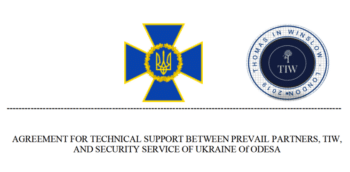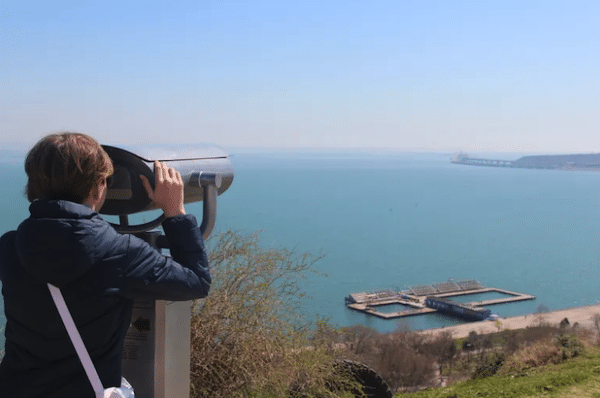The Grayzone has exposed British intelligence freelancers for collaborating with Ukraine’s Security Service to destroy Kerch Bridge. Leaked documents suggest they played a role in the latest attack on the bridge, and may be helping Kiev hunt down accused collaborators.
On July 16, a predawn assault on the Kerch Bridge connecting Crimea with mainland Russia left two civilians dead and a 14-year-old injured. As advisors to Ukrainian President Volodymyr Zelensky hinted at Ukraine’s culpability, Russian President Vladimir Putin pointed his finger at Kiev and vowed revenge.
The attack was the second attempt at destroying the Kerch Bridge in less than a year. On October 8th 2022, a suicide attacker remotely detonated a truck bomb on the bridge, killing three and inflicting such severe damage the vehicular crossing remained closed until February this year, while railroad traffic resumed in May.
As The Grayzone revealed two days after the bombing, a cabal of British mlitary-intelligence freelancers had drafted detailed plans for destroying Kerch Bridge months earlier. The blueprints were drawn up at the behest of Chris Donnelly, a senior intelligence operative and former high ranking NATO advisor. His transnational nexus manages London’s contribution to the proxy war at arm’s length, in conjunction with the Security Service of Ukraine’s (SBU) Odessa branch.

After an initial burst of Ukrainian public and governmental celebration in the wake of the first Kerch bombing, officials in Kiev quickly backtracked, claiming it was in fact a Russian false flag. In May this year, SBU chief Vasyl Maliuk finally admitted his agency undertook “certain measures” to carry out the attack, coercing an innocent truck driver into unwittingly and unwillingly serving as a suicide bomber.
This time, the SBU appears to have used unmanned submarines to target Kerch Bridge with explosives. A review of leaked files previously revealed by The Grayzone provides a solid basis for again blaming Donnelly’s cabal.
These files show Prevail Partners as the cutout enlisted to train a secret Ukrainian partisan army to target Russian territory with terror attacks. Prevail pledged to provide the SBU with extensive targeting expertise and technology for operations targeting Crimea – particularly, the Kerch Bridge. They also raise grave questions about whether the Ukrainian Security Service is being assisted in its criminal war on collaborators by Donnelly’s shadowy clique.

British ‘boots on the ground’ in Ukraine
From the perspective of Donnelly’s intelligence cabal, the Odessa branch of the Ukrainian SBU Security Service was perfectly positioned to wreak havoc on Crimea. Located just over the Black Sea and filled with hardcore Maidan operatives, the unit signed a “technical support” agreement with Prevail and Thomas in Winslow (TIW), a self-described “crisis management company”, not long after Russia’s invasion.
Under the terms of the deal, Prevail and TIW conducted a “capacity assessment” of the Security Service’s capabilities, identifying areas where they could assist. The findings were then leveraged to “secure programmatic funding from the international community or donor countries.” This would cover services such as training the underground partisan army, to attack Crimea.
As part of the assessment by Prevail, representatives of the British company and TIW confidentially met in person with the Odessa SBU’s deputy director. The secret summit focused “heavily on targeting and specialist capability to support that function.” Prevail and TIW felt they could “add huge benefit” to the SBU’s existing human intelligence and electronic data capture capabilities, due to their “collective experience in targeting the adversary.” This would produce “confirmative/actionable intelligence,” enabling a range of covert and overt activities.
Among other things, the proposal called for the SBU to be taught how to “monitor coastline and Russian movement” with surveillance drones, and be granted access to satellite imagery to assist targeting in military and black operations. This would “go a long way,” a British operative remarked. The Security Service would also be taught how to “exploit encrypted data” stored on digital devices appropriated from captured or killed Russian soldiers.

In closing, the assessment noted that in order to bring Prevail and TIW’s skills and technologies in-house, representatives of Odessa SBU “understand that with capability comes a training burden, and the need to have dedicated mentors/advisors inside their tent.”
As one Prevail staffer put it, “they seemed impressed by our willingness to establish a presence with them – support and mentorship – boots on the ground.”
Immediately after their meeting with the Security Service of Odessa’s deputy director, representatives of Prevail and TIW reached out to the government of Ukraine to outline joint plans to support Kiev’s war effort and address the SBU’s “urgent operational requirements.”
 The assessment’s introduction noted that “not all points” from the Security Service’s “original ask” were discussed in the meeting. Some clue as to what this “ask” may have included could be provided by a presentation titled “Kerch Bridge info pack.” It was prepared by a “geospatial intelligence” specialist at the firm on the same day that Prevail issued its letter of intent to Kiev, in April 2022.
The assessment’s introduction noted that “not all points” from the Security Service’s “original ask” were discussed in the meeting. Some clue as to what this “ask” may have included could be provided by a presentation titled “Kerch Bridge info pack.” It was prepared by a “geospatial intelligence” specialist at the firm on the same day that Prevail issued its letter of intent to Kiev, in April 2022.
The proposal laid out various scenarios for blowing up Kerch Bridge. Some went far further than what actually transpired. One speculative plot involved detonating a vessel containing ammonia nitrate directly under the bridge. The August 2020 Beirut blast, which killed at least 214 people, injured thousands, and inflicted billions in property damage, was approvingly cited as an example to emulate.
This June, as Ukraine’s heavily anticipated counteroffensive faltered in the country’s eastern flatlands, CIA Director William Burns arrived in Kiev to review a so-called “victory plan” put forward by the country’s military and intelligence directors. At the top of the agenda was “holding hostage” the population of Crimea. Just over three weeks later, Ukraine attacked Kerch Bridge for a second time.
The Ukrainian military presented CIA director William Burns with its "ideal scenario"
"holding hostage" the entire population of Crimea by bombarding it with "powerful weapons" to "gain leverage" over Russia
In other words, state terrorhttps://t.co/hUlHGP4MU2 pic.twitter.com/ye33bj7Wet
— Max Blumenthal (@MaxBlumenthal) July 2, 2023
While thousands of civilian journeys are conducted over the Kerch Bridge each day, the pair of Ukrainian attacks have targeted civilian areas, killing innocent people while leaving Russian forces unaffected, it is a vital artery for Moscow to supply its soldiers battling Ukraine’s counteroffensive in the south of the country. Whether Kiev’s efforts to destroy the structure amount to war crimes is therefore an open question.
Ukraine’s government has simultaneously waged a ruthless war on accused collaborators while international rights groups and the Western media look the other way. These killings constitute unambiguous crimes against humanity.
The leaked files revealed by The Grayzone show that Prevail and TIW may have provided Odessa SBU with support in identifying and locating suspects, and possibly participated in Ukraine’s violent political purge.

Ukraine’s ‘pro-Russia’ contingent in the crosshairs
Since Russia’s invasion of Ukraine, Kiev’s crusade against purported “collaboration and treason” has led to thousands of cases being opened. As a UN Human Rights High Commissioner report noted in June, 500 guilty verdicts have already been passed down, with penalties ranging from fines to 15 years in prison.
The Commissioner documented how many individuals suspected of collaboration have been subject to arbitrary detention and brutal torture. “Enhanced” interrogation methods recorded by the UN included beatings, electrocution, sexual violence, forced nudity, threats of genital mutilation and rape against detainees and their loved ones, threats of execution, loaded guns, and of being brought to the front line and abandoned there.
The OHCHR expressed serious concern that the Ukrainian law criminalizing “collaboration activities” does not define what these activities actually are, “or other important terms with sufficient precision so as to enable individuals to regulate their conduct and reasonably foresee the legal consequences of their actions or inaction.” Some “collaborators” simplyaccepted food and other aid from occupation troops. Others continued to work under occupation, as in the case of several teachers facing jail.
Curiously absent from the report was any reference to the summary murder of collaborators. Despite the Western media openly cheering these rampages, Ukrainian soldiers producing grim TikTok videos documenting their capture of suspects and even filming their subsequent murder, and officials in Kiev openly hailing the savage efficacy of state-directed hit squads conducting cleanup operations in formerly Russian-occupied territory, the openly promoted acts of sadistic political violence somehow slipped past OHCHR investigators.
“A hunt has been declared on collaborators and their life is not protected by law,” fulminated Anton Gerashchenko, an advisor to the Ukrainian Interior Ministry, in October 2022. “Our intelligence services are eliminating them, shooting them like pigs.”
Are Donnelly’s people assisting in this macabre campaign? Records of the consultation between Prevail, TIW, and the Odessa SBU’s deputy director strongly suggest so. At this early stage of the conflict, the agency already considered keeping a close eye on movements and statements of the city’s “pro-Russian contingent” to be a “top priority”, although it had so far struggled to do so effectively. The file notes:
“Tracking and monitoring of devices played a key role in the conversation. [Odessa SBU] have existing methods and capability to track phones but highlighted that they had no way to identify users. They mentioned that their capability often tracked Russian phones that led them to legitimate civilians. This is an area we can support. We discussed…alternate methods to track and monitor such as app-based technology, and they were visibly impressed and excited at the prospect.”

The “app-based technology” referred to was Anomaly 6’s illegal global surveillance dragnet, which according to leaked documents, is being used for targeting by the Ukrainian Armed Forces. As The Grayzone has reported, Anomaly’s smartphone spying technology is nowhere near as precise as the company’s marketing material has claimed.
The risk of systemic errors that lead to the branding of innocent civilians as Russian collaborators or spies will almost inevitably cost lives. There is also the risk it could facilitate the arrest and extradition of Ukrainian refugees in Europe, given Kiev is now working with Interpol to track down suspected collaborators who fled to the European Union.

